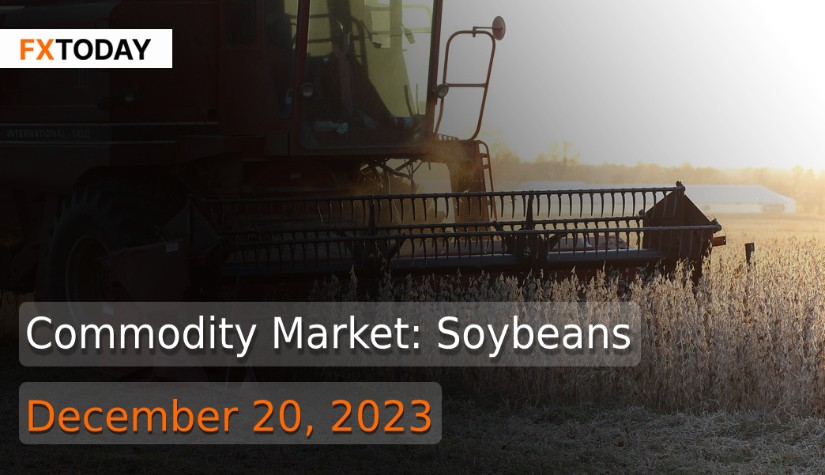Soybean Prices React to South American Weather
On Tuesday, soybean prices experienced a decline, influenced by the weather forecast for South America. The market reacted to the expectation of beneficial rains in central and northern Brazil, signaling a return to a more normal rainy season in January. While a record crop seems unlikely for Brazil, the crop is still anticipated to be better than average, with growth expected in the Argentine crop, posing increased competition for U.S. soybeans. Export sales are currently below the estimated pace, and soybean meal prices also fell. Traders are closely monitoring Argentina's potential two-percentage-point increase in soybean product taxes.
The total U.S. oilseed production for 2023/24 is forecasted at 121.5 million tons, with a slight decrease due to reduced cottonseed production. Projections for soybean supply and use remain unchanged, with a season-average soybean price forecast of $12.90 per bushel. Global oilseed production for 2023/24 is estimated at 661.0 million tons, down by 0.5 million from the previous month. Lower soybean and sunflowerseed production are partly offset by increased rapeseed production. Brazil's soybean production is lowered due to hot and dry conditions, while Canada and Russia show higher production.
Brazil, the world's largest soybean exporter, achieved a historic milestone by exporting over 100 million metric tons of soybeans within a year, driven by a record harvest and lower international prices. However, this record was set at the expense of lower prices for Brazilian farmers. Importers, including China, took advantage of the lower prices to build up stocks rather than significantly increasing consumption. The recent uptick in soybean purchases from the U.S. is attributed to lower U.S. prices and expectations of a smaller crop in Brazil due to adverse weather conditions.
Outside market developments are playing a significant role in the grain markets, with factors like Brazil's impact on corn and soybeans and the diminishing wheat demand due to Russia having a substantial influence. Brazil's ability to keep increasing cropland, poses a challenge to the U.S. as Brazil aims to maintain its status as a major exporter. The destruction of the Amazon forest for cropland expansion is a concern addressed at international climate conventions.
In the soybean futures market, prices edged lower on Tuesday due to improved weather in Brazil. However, strong demand for U.S. exports, especially from China, limited the losses. Investors are closely monitoring weather forecasts for South America, where recent rains have benefited crops in northern Brazil. Additionally, a deadly summer storm in Argentina has brought much-needed rains but temporarily disrupted operations at a key grains port.
In the Chicago Board of Trade (CBOT) soybean futures market, prices experienced some fluctuations and are influenced by weather conditions in South America. Analysts suggest a possible trading range between $1300.00 support and $1335.00 resistance.
Technical analysis indicates a bearish trend in soybean prices, with expectations of further decline if the price remains below $1330.00. The USDA's Foreign Agricultural Service reported another sale of U.S. soybeans, marking the ninth day of sales in the last ten business days. Tight soybean supplies and increased renewable fuel demand could encourage more soybean planted acres in the coming year.
Finally, despite improved weather in parts of South America, factors like China's record corn imports, Argentina's export tax hike plans, and ongoing strong demand for U.S. exports contribute to the complexity of the soybean market dynamics.
Data for Technical Analysis (5H) CFD US Soybeans Futures - Jan 24 (ZSF4)
Resistance : 1319.54, 1321.2, 1323.87
Support : 1314.2, 1312.54, 1309.87
5H Outlook
Source: Investing.com
Buy/Long 1 If the support at the price range 1309.2 - 1314.2 is touched, but the support at 1314.2 cannot be broken, the TP may be set around 1321.12 and the SL around 1307.0, or up to the risk appetite.
Buy/Long 2 If the resistance can be broken at the price range of 1319.54 - 1324.54, TP may be set around 1329.00 and SL around 1312.0, or up to the risk appetite.
Sell/Short 1 If the resistance at the price range 1319.54 - 1324.54 is touched, but the resistance 1319.54 cannot be broken, the TP may be set around 1314.12 and the SL around 1327.00, or up to the risk appetite.
Sell/Short 2 If the support can be broken at the price range of 1309.2 - 1314.2, TP may be set around 1307.10 and SL around 1322.00, or up to the risk appetite.
Pivot Points Dec 20, 2023 08:24AM GMT
|
Name
|
S3
|
S2
|
S1
|
Pivot Points
|
R1
|
R2
|
R3
|
|---|---|---|---|---|---|---|---|
| Classic | 1307.12 | 1309.87 | 1314.12 | 1316.87 | 1321.12 | 1323.87 | 1328.12 |
| Fibonacci | 1309.87 | 1312.54 | 1314.2 | 1316.87 | 1319.54 | 1321.2 | 1323.87 |
| Camarilla | 1316.46 | 1317.1 | 1317.74 | 1316.87 | 1319.02 | 1319.66 | 1320.31 |
| Woodie's | 1307.88 | 1310.25 | 1314.88 | 1317.25 | 1321.88 | 1324.25 | 1328.88 |
| DeMark's | - | - | 1315.5 | 1317.56 | 1322.5 | - | - |
Sources: Hellenic Shipping News, XM
Maximize your knowledge: Blog
















